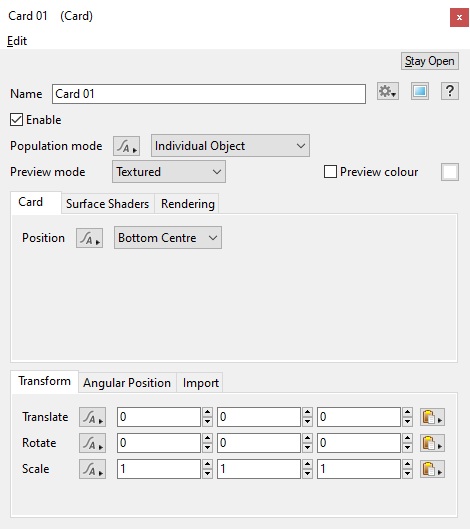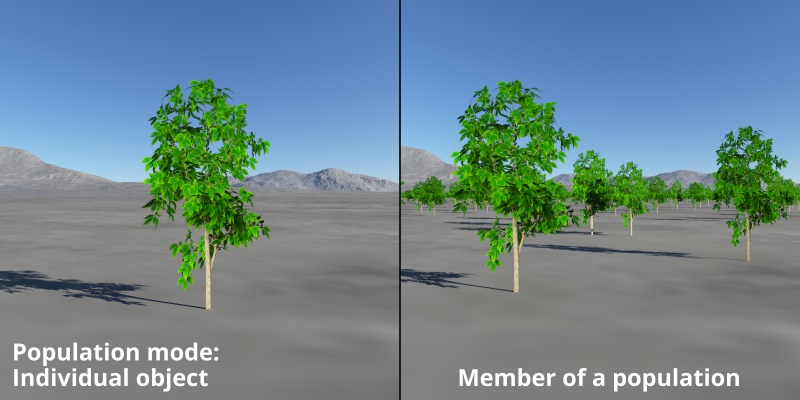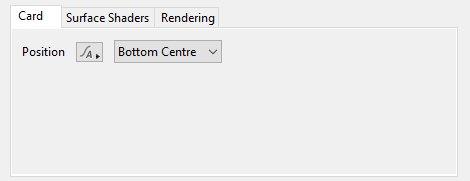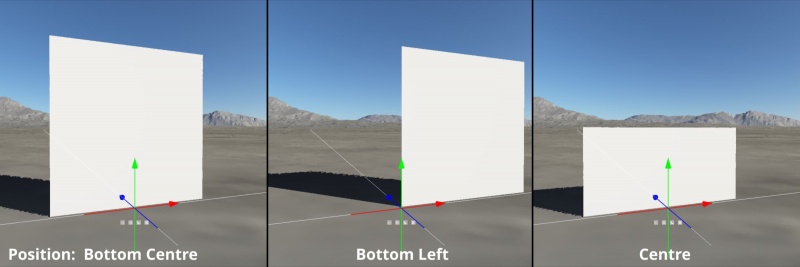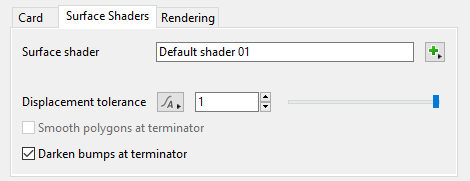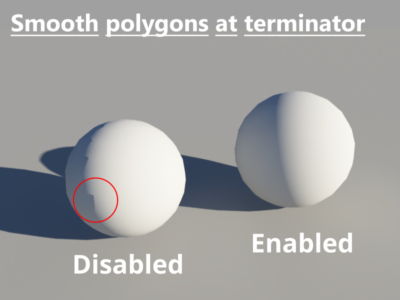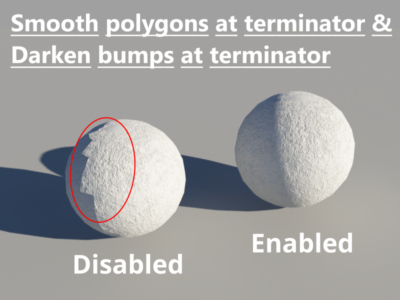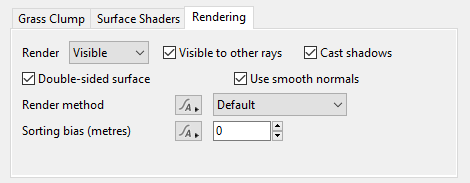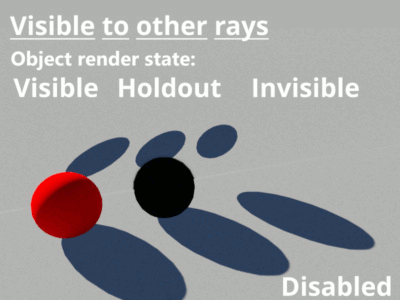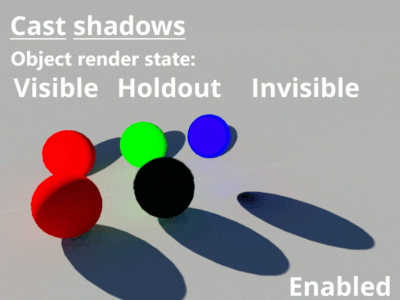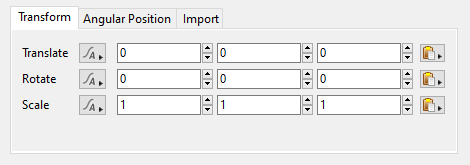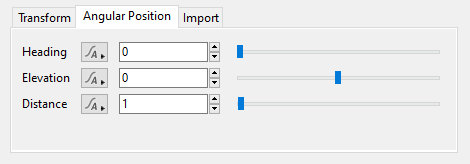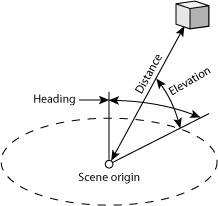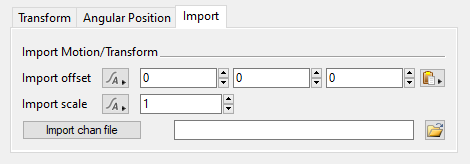Card
Contents
Overview[edit]
The Card is a rectangular plane object. Although this is similar to the Plane object the Card has some advantages as it’s easier to use and can also be populated. The Card is a good object to use as a billboard. It's upright by default and can be positioned using the bottom centre. The tex coords/UVs are also set up to be suitable for a billboard. Simply assign your billboard image in the Default Shader node that's created along with the object.
Cards can be moved (translated), rotated, and scaled on the Transform tab. The Surface Shaders tab allows you to assign shaders or function nodes that will be applied to the object.
Settings:
- Name: This setting allows you to apply a descriptive name to the node, which can be helpful when using multiple Card nodes in a project.
- Enable: When checked, the node is active and the Card object will appear in the scene with the settings below applied to its surface. When unchecked, the node is ignored.
- Population mode: This popup has two options:
Individual Object: This is the default for Card objects created individually, not part of a population. If you choose this option for Card objects that are part of a population the population instances will still render but the Card object itself will also show up at its original position.
Member of a Population: This is the default for Card objects created as part of creating a population. It means the Card objects only render as part of a population. If you choose this option for an individual Card object it won't render. If you create a Card object as part of a population and then decide to use it on its own you may need to change the popup to Individual Object to get it to render.
- Preview mode: This popup has five options to let you choose how the object should be displayed in the 3D Preview, and sets the most detailed mode that the object can be displayed in. The Object Display Mode button in the 3D Preview controls the mode for the preview as a whole. For example, if you set the Preview mode of the object to Wireframe but the 3D Preview object display mode is set to Show as bounding boxes then the object will only be drawn as a bounding box.
-
[[File: OBJReader_02_PreviewMode.png | none|234px|Preview mode options
- Preview colour: Enabling this parameter causes the Card object to be drawn in the 3D preview using the preview colour when the Card object display mode is set to Show as bounding box or Show as wireframe. When set to Show as smooth shaded or Show as textured the preview colour tints the Card object’s textured surface. This is useful for making a particular Card object stand out in the 3D preview. Clicking on the colour swatch to the right of the parameter label opens the Colour Picker pane.
Card Tab[edit]
- Position: This popup menu has three options to let you choose the pivot point location of the Card object. The pivot point, or object’s origin, is the point at which you can scale the Card object up or down, or translate and rotate it around in your scene.
Bottom Centre: When checked, the Card object’s pivot point is located along its bottom edge and halfway between its width.
Bottom Left: When checked, the Card object’s pivot point is located at its bottom left edge.
Centre: When checked, the Card object’s pivot point is located halfway between its width and height.
Surface Shaders Tab[edit]
This tab lets you assign a surface shader to texture the Card object.
- Surface shader: Use this setting to assign a surface shader or function nodes to the Card object.
- Displacement tolerance: If you find that rough or spikey surfaces are showing problems at bucket edges, for example spikes having cut off tops, or gaps in ray traced shadows then increasing this value may help. However this can greatly increase render times. Relatively flat surfaces may render more quickly with smaller values. The default value is 1. However this is an advanced setting and you should not change it unless you have a specific problem you need to address. If you are having problems try starting with 2 and then increase it by small increments until they're resolved. A value of 4 would be considered a high value.
- Smooth polygons at terminator: This fixes self-shadow artifacts at the lighting terminator of polygonal objects where the smooth normals are inconsistent with the geometric normal. This parameter is enabled by default.
- Darken bumps at terminator: This setting approximates self-shadow of bump maps at the lighting terminator to reduce the chance of seeing a sharp line where the surface falls into shadow. This setting is enabled by default.
Rendering Tab[edit]
- Render: An object's render state can be set to Visible, Invisible or Holdout. When set to Holdout, an object is visible in the rendered image as a black shape with an alpha value of zero. When using render layers the object's render state is combined with the group visibility parameter to determine its least visible setting. Invisible is less visible than Holdout, which is less visible than Visible.
- Visible to other rays: When enabled, the grass clump object will be taken into account by all the rays determined by the renderer including those from the camera, direct and indirect lighting, etc. In the example below, a 100% reflective 3D object has been placed behind three coloured spheres in order to mirror the effect of the calculated rays.
- Cast shadow: When checked, the grass clump object will cast shadows.
- Double-sided surface: When checked, the grass clump object surfaces are double sided. A single sided surface is only visible from the "front", which is the direction the surface normal is pointing. If you look at it from the other direction the surface isn't visible. Double sided surfaces are visible from all directions.
- Use smooth normals: When checked, the grass clump object normals are interpolated to make the surface appear smooth. When unchecked, its surface will look faceted
- Render method: This popup has three options.
Default: Ray Tracing is the default rendering method for an object. Typically it results in higher quality and faster rendering. When displacement is applied to a 3D object the render method should be changed to Force Displacement. When the object's render method is set to Default, the object is rendered according to the Ray trace objects setting in the render node.
Force Displacement: When enabled for the grass clumpp object, its surfaces will be subdivided into micropolygons at render time, which allows the 3D geometry to be displaced correctly but at the expense of slightly longer render times. It is useful when you have some objects you want to render with displacement but you don't want to change how all the rest of your objects are rendered, i.e. Ray traced.
Force Ray Trace: When enabled for the grass clump object, its surfaces will be ray traced at render time, even if Ray trace objects is disabled in the Renderer settings. This can be useful when Ray trace objects is disabled in the Renderer in order for other 3D objects to use displacement, but you want this object to use ray tracing for the highest quality rendering and it has not been displaced.
- Sorting bias (metres): This setting gives you control over the order in which objects are rendered when using the micropolygon renderer. This does not apply to objects being rendered with the ray tracer. A large positive value, e.g. 10,000,000 (or 1e7) will usually force the object to render first. A large negative value, e.g. -10,000,000 (or -1e7) will usually force the object to render last, or after the terrain. This can be useful when rendering large objects with displacement, such as a lake object that lies mostly below the displaced terrain. By setting the lake object’s Sorting bias (metres) value to something like -10,000,000 forces it to render after the terrain.
Transform Tab[edit]
- Translate: This sets the position of the grass clump object.
- Rotate: This rotates the grass clump object about its origin. The order of the values is heading, pitch then bank.
- Scale: This sets the scale of the grass clump object in the X, Y and Z directions.
Angular Position Tab[edit]
This tab has settings which use angles and distance to set the position of the grass clump relative to the scene origin. These settings are an alternative to using the Translate setting in the Transform tab. The diagram below shows how all the parameters relate to each other and the origin.
- Heading: This angle sets the rotation of the grass clump object around the scene origin, in the XY plane, increasing as you turn clockwise.
- Elevation: This angle sets the vertical part of the position. You could think of it as the angle above or below the horizon. 90 is straight up, -90 is straight down.
- Distance: This sets the distance of the grass clump object from the origin, in metres.
Import Tab[edit]
These settings apply to .chan/.mov and FBX import.
- Import offset: This setting allows you to offset the positions imported from the file. As an example, you might want the positions imported from the file to be moved 10 metres in the X direction. To do that enter 10 for the X coordinate and import the file.
- Import scale: You can use this setting to scale values imported from the file.
- Import chan file: This setting specifies the file to be imported. When you choose a new file you will be prompted to import the file. If you choose not to import it immediately you can click the Import chan File button to perform the import.
A single object or device in the node network which generates or modifies data and may accept input data or create output data or both, depending on its function. Nodes usually have their own settings which control the data they create or how they modify data passing through them. Nodes are connected together in a network to perform work in a network-based user interface. In Terragen 2 nodes are connected together to describe a scene.
The bounding box is a box which surrounds (or bounds) an object or shader. This box shows the maximum extents of the item inside it. Sometimes abbreviated as "b-box".
A parameter is an individual setting in a node parameter view which controls some aspect of the node.
A shader is a program or set of instructions used in 3D computer graphics to determine the final surface properties of an object or image. This can include arbitrarily complex descriptions of light absorption and diffusion, texture mapping, reflection and refraction, shadowing, surface displacement and post-processing effects. In Terragen 2 shaders are used to construct and modify almost every element of a scene.
When Terragen renders, it divides the image up into buckets or tiles. Each bucket is rendered separately, allowing multiple buckets to be rendered at once. It also allows memory to be used more efficiently.
Literally, to change the position of something. In graphics terminology to displace a surface is to modify its geometric (3D) structure using reference data of some kind. For example, a grayscale image might be taken as input, with black areas indicating no displacement of the surface, and white indicating maximum displacement. In Terragen 2 displacement is used to create all terrain by taking heightfield or procedural data as input and using it to displace the normally flat sphere of the planet.
